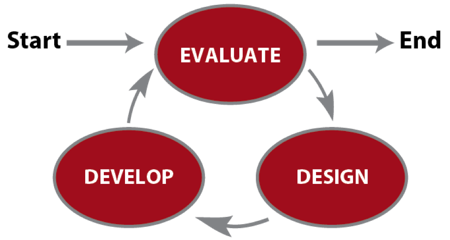Blog
Webinar: Why Manhattan Associates ♥ SAM
Over the years, we have taught many workshops on SAM (Successive Approximation Model) and have given even more talks on the subject. In these ...

.png?width=1387&height=526&name=2023%20Blog%20Covers%20and%20In-Line%20Graphics%20(2).png)
3 Easy Ways to Get Started With the Successive Approximations Model
By Allen Interactions | January 02, 2024 | Custom Learning | 0 Comments
Over the years, we have taught many workshops on SAM (Successive Approximation Model) and have given even more talks on the subject. In these workshops and talks, we often see the same basic questions. But, the one question we can guarantee we will be asked is, “How do I implement SAM in my organization?”

While we are always happy to be asked this question, this is tough to answer! Since we encounter this question so frequently, we can focus our answer on a few key factors that increase the likelihood of success.
Our team often uses the phrase “moving the needle” to describe the efforts when implementing SAM in an organization. By “moving the needle”, someone is making incremental changes that produce noticeable results. Our three tips will help ensure that you can start incorporating the Successive Approximations Model in your organization - and start to see results.
There is no better way to build excitement for the power of an iterative design than to kick off with an active brainstorming and sketching session, which is called the Savvy Start in SAM.
Sure, we recognize that you might face resistance when asking for the time required of a Savvy Start (as described in the book). Still, perhaps you can facilitate a one-hour brainstorming session on a single performance event or objective. The energy and excitement generated from a robust brainstorming/sketching/prototyping event go a long way to building credibility within the organization for a new instructional design approach.
Select a Project That is Reasonable in Size to Begin
SAM is a powerful process that can handle even the largest learning and development projects. But, when it’s your first attempt at it in your organization, discretion is the better part of valor.
In line with this approach, you may opt to pick a small part of a bigger project to implement SAM principles and activities. Either way, make sure that you give yourself, and SAM, the best chance for early success.
Find Places In Your Organization Where You Can Add SAM Principles and Practices
Often the processes we use to design and develop learning events are a combination of ISD practices and organizational requirements. These processes usually look for the opportunity for approval and review, not for how a deliverable is created – giving plenty of ways to incorporate iterative design.
For example, instead of spending more time analyzing content, why not have a brief brainstorming, sketching, and prototyping meeting with a few colleagues? Both of these strategies can help you create a design document, but by challenging your design with others, you are more likely to arrive at a higher-quality product.
.png?width=135&height=135&name=ai-symbol-green%20(3).png)
About the Author: Allen Interactions
Comments
Would you like to leave a comment?
Related Blog Posts
.png?width=316&name=Social%20-%20Webinars%20(1).png)
By: Allen Interactions | Feb, 2013
Category: News

Blog
Angry Bird's Implications for m-Learning
Over the years, we have taught many workshops on SAM (Successive Approximation Model) and have given even more talks on the subject. In these ...
By: Allen Interactions | Mar, 2012
Category: Custom Learning

Blog
If You Build It, Will They Come? Why Marketing Your Learning is Vital to ...
Over the years, we have taught many workshops on SAM (Successive Approximation Model) and have given even more talks on the subject. In these ...
By: Allen Interactions | Sep, 2013
Category: Custom Learning
